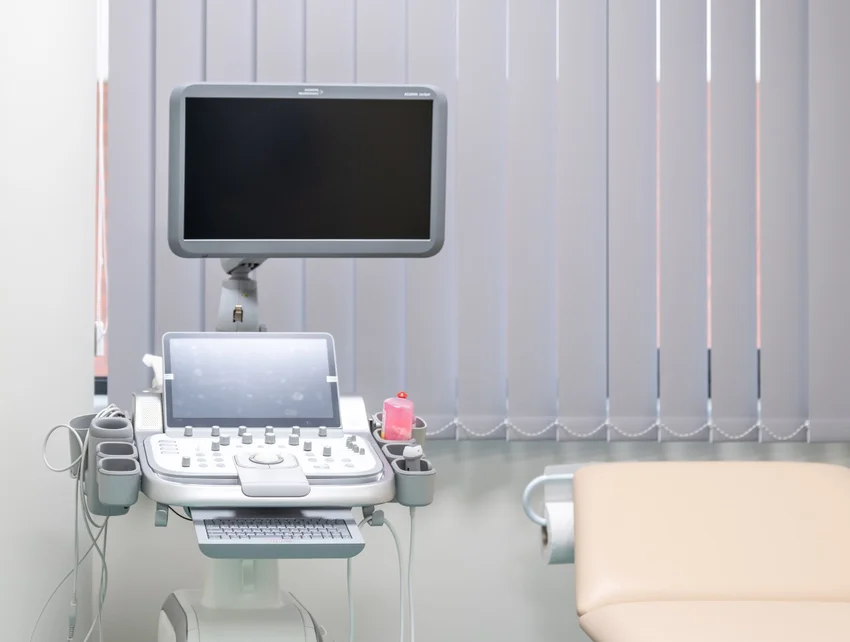This is how our application simplifies the booking and administration process. Interested >>
Ultrasound scan
Ultrasound is an imaging technique in which the examining doctor receives visual information in the form of images using sound waves that are inaudible to the human ear. The procedure is painless and does not harm the body.

Benefits of ultrasound scans
According to the current state of medicine, this procedure does not have risks as opposed to CT scans and X-ray scans, which use ionizing radiation. Ultrasound scans are widely used in different fields of medicine e.g., internal medicine, cardiology, endocrinology, gynecology, vascular surgery, urology, and orthopedics. This method provides a real time image, so the scanned organ may be examined during movement too.
It can be used for diagnostic purposes as well as to monitor disease progression or the success of a treatment, and additionally, it can support certain procedures and interventions. An ultrasound scan provides an accurate picture of the consistency (texture, density), shape and size of the scanned tissues and soft tissues, making various disorders, inflammatory processes, benign or malignant neoplastic abnormalities, cysts, fluid effusions, stones, stenoses, congestions and organ enlargements detectable.
Ultrasound scans have a wide range of use including joints, liver, gall bladder, kidneys, pancreas, thyroid gland, ovaries, urinary bladder, uterus, vessels, blood flow, lymph nodes, heart, breasts, spleen, and testicles.
Since an ultrasound scan does not pose any radiation to the body, it does not have any side effects, which makes it the first scan of choice in the diagnostic process, and it also has a special role in gynecological, infant, and pediatric care.
An additional argument for the preferential use of ultrasound is that the scan is completely pain free, no incisions or injections are needed.
Limitations of ultrasound scans
Ultrasound is poorly transmitted through air, and it does not pass through bones, so it is not suitable for scanning those organs which are filled with air or covered by bones such as the lungs or the brain. An ultrasound scan may have limitations when it comes to the deeper tissues of the body.
How are ultrasound scans performed?
Most ultrasound scans do not require any preparations, but there are some exceptions. For example, you must come to an abdominal ultrasound scan with any empty stomach, meaning that you cannot eat or drink 6 hours before to the scan. The optimal way to scan the lesser pelvis is with a full urinary bladder.
The patient is awake during the scan. It is recommended to wear comfortable clothes, which are easy to put on and take off, since the region that is supposed to be scanned by the ultrasound has to be uncovered. Jewelry might need to be removed too. The optimal transmission of the ultrasound is supported by a gel, which can be easily removed, washed off of the skin. Without this gel, the waves would bounce back from the air. In some cases, an ultrasound scan is not performed through the skin, instead, the physician performs the scan inside body cavities.
How does ultrasound work?
After applying gel, the ultrasonic transducer which emits high-frequency sound waves is placed right above the skin of the region, which is meant to be scanned, or the transducer is introduced into a body cavity. One part of these sound waves will be absorbed by the body, but another part of them will bounce back from the tissues and organs. The transducer receives the reflected waves, transforming them into electrical signals, and transmitting them to a computer which then will visualize the received data to the professional user as images – this will be the result of the ultrasound scan.
Chief radiologist Dr. Mária Puhl contributed to the creation of this description.
Feel free to contact our specialists!
At the Buda Health Center, you have the opportunity to attend the private practices of more than 300 renowned specialists, offering expertise in nearly 45 medical specialisms, at five locations. Personalized care is provided by a well-trained and empathetic staff of professionals, who have been working together for a long time. Based on our 24 years of experience and the feedback received from our 450,000 clients, we are constantly working to organize our healthcare services in the most efficient way possible for those who visit us, paying respect to their needs and time.
